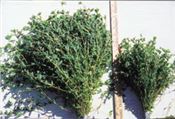Legumes – Don’t Overlook The Double-Crop Option

Legend lespedeza, left, is now in its 22nd year of commercial production.
KEITH CARMICHAEL
LOWRY CITY, MISSOURI
Legumes more than pay their own way. I’m sure you have priced nitrogen lately. There is another source. Legumes added to the pasture or hayfield produce nitrogen which eventually becomes available to grasses as well and they are a very important protein source. Without legumes in the pasture you really don’t have your very best pasture or hay scenario. You really don’t have your best intake, performance, or gain. You’re leaving money on the table. Over-seeding pastures and hay fields with legumes is basic, common-sense management. No single legume can do it all. Soil fertility, pH, texture, and drainage all help determine which legume is best for your operation. If you believe in having forage quality and diversity like the professionals, use several types of clover and perhaps alfalfa if your soil pH will support it. If not, you should insist on annual lespedeza. The taller, more productive Legend lespedeza has proven to be a very productive summer forage for almost two decades.
Double Crop Lespedeza after wheat for Summer Grazing or Hay When wheat harvest and straw baling is finished, there can be other options besides soybeans. Many producers use summer annual forages for grazing to either fill that summer slump or keep livestock gaining.
Wheat acres provide an excellent opportunity for double cropping with forages that when harvested at the proper growth stage can provide high quality late gestation – early lactation forage.
Annual Lespedeza
Annual Lespedeza is well known for its unique tolerance to drought and low pH soils. It is also one of the few legumes that does not cause bloat. Adding annual lespedeza with other legumes into cool-season grass pastures can mean extra forage and therefore extra pounds because many grasses often leave a significant forage gap in summer months. Milk production, weaning weights and reproductive efficiency are all closely tied to the animal nutrition during this period. So, if you want cows to milk and breed, and calves to gain during the summer make sure you have annual lespedeza in your plan.
Legend Lespedeza – now in its 22nd year
From northern Missouri and southeast Kansas to Georgia there has been renewed interest in annual lespedeza mostly because of the success of Legend lespedeza. This annual-striate lespedeza that has been grown effectively for both pasture and hay all over the lower Midwest and throughout the South is now in its 22nd year of commercial production.
Compared to other types, the taller Legend exhibits a greater leaf to stem ratio. In some tests the advantage in dry-matter yield has proved to be 2 to 1. Producers who have grown a variety of lespedezas over the years characterize Legend as a “very leafy lespedeza that grows taller and reseeds itself very well”.
Annual lespedeza should not be confused with its perennial cousin – Sericea which is a serious weed problem in many areas.
Spring, Summer and Fall
When planting the newer, safer types of fescues, or other cool-season grasses, lespedeza is the one legume that can be recommended as a companion the first season because it does not compete aggressively with the new grass early in the spring.
The effects of endophyte toxicity in some fescue pastures during the summer are hard to measure, but well documented. This fungus affects all of animal performance – especially reproduction. Annual lespedeza in pastures can ‘dilute’ and significantly reduce its effect. With annual lespedeza, it’s all about ‘timing’!
Lespedeza management and Fall Stockpiling Fall stockpiling of fescue pasture is very important in many operations and the management required to stockpile this forage fits very well in allowing annual lespedeza to re-seed itself.
For More information visit www.Legendlespedeza.com. ∆